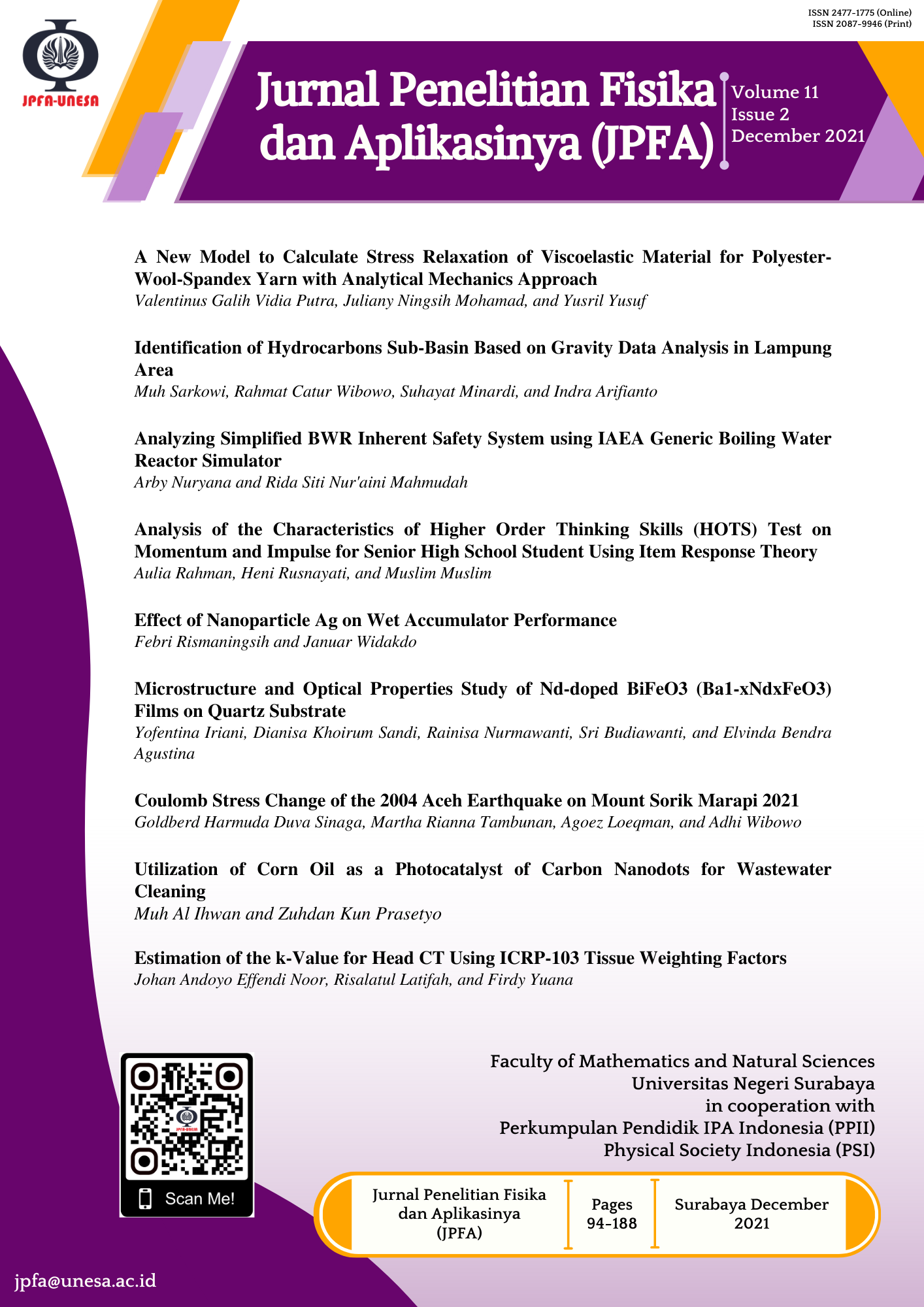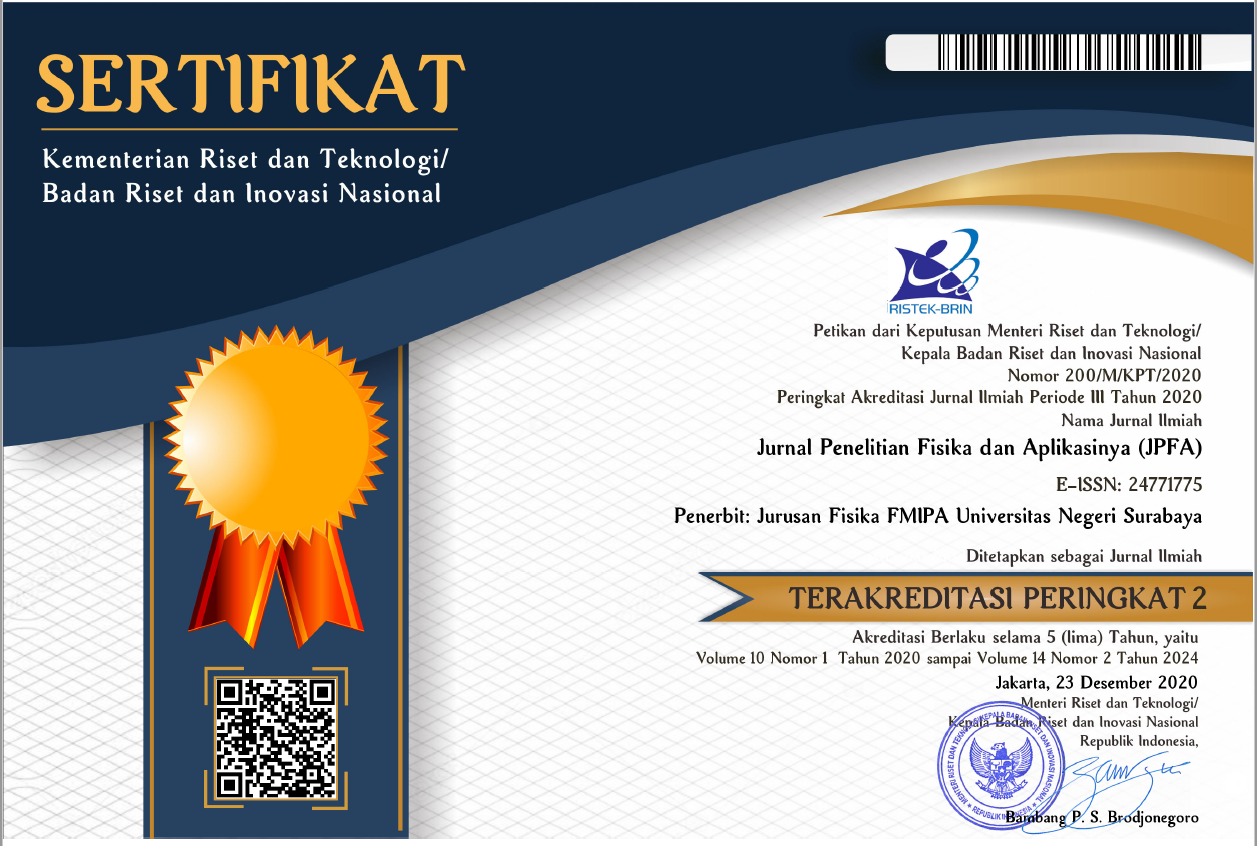A New Model to Calculate Stress Relaxation of Viscoelastic Material for Polyester-Wool-Spandex Yarn with Analytical Mechanics Approach
DOI:
https://doi.org/10.26740/jpfa.v11n2.p94-105Keywords:
, viscoselastic yarn, analytical mechanics, stress relaxationAbstract
Many researchers have studied the mechanical properties of yarn in textile science because mechanical properties are the essential parameter in determining yarn quality. This research aims to make a new model and prediction of the material properties of textile yarns, especially for stress relaxation of viscoelastic textile yarn for polyester-wool-spandex yarn cases. In this research, a new approximation of the analytical mechanics model of stress relaxation using a system of four springs and a dashpot to determine viscoelastic yarn properties as polyester-wool-spandex has been studied. A yarn movement equation for viscoelastic yarn as polyester-wool-spandex having 36 yarn count number (in unit tex or g/km) has been formulated using analytical mechanics, and the model has been validated experimentally. The coefficient of determination R2 ranges from 0.82, which shows the closeness between the experimental results and the theoretical predictions. In this research, it is found that this model can be implemented to determine the viscoelastic material of yarn based on the properties of yarn as stress relaxation using the analytical mechanics approach.
References
Chailleux E and Davies P. Modelling the Non-Linear Viscoelastic and Viscoplastic Behaviour of Aramid Fibre Yarns. Mechanics of Time-Dependent Materials. 2003; 7(3): 291-303. DOI: http://dx.doi.org/ 10.1023/B:MTDM.0000007199.01142.f8.
Chailleux E and Davies P. Non-Linear Viscoelastic: Viscoplastic Model for the Behaviour of Polyester Fibres, Mechanics of Time-Dependent Materials. 2005; 9: 147-160. DOI: https://doi.org/10.1007/s11043-005-1082-0.
Chen X. Modeling and Predicting Textile Behaviour, New York: CRC Press; 2010.
Putra VGV, Maruto G, and Rosyid MF. New theoretical modeling for predicting yarn angle on OE yarn influenced by fibre movement on torus coordinate based on classical mechanics approach. Indian Journal of Fibre and Textile Research. 2017; 42(3): 359-363. Available from: http://op.niscair.res.in/index.php/IJFTR/article/view/8685.
Putra VGV, Rosyid MF, and Maruto G. A Simulation Model of Twist Influenced by Fibre Movement Inside Yarn on Solenoid Coordinate. Global Journal of Pure and Applied Mathematics. 2016; 12(1): 405-412. Availale from: https://www.ripublication.com/gjpam16/gjpamv12n1_37.pdf.
Liu H, Tao XM, Choi KF, and Xu BG. Analysis of the Relaxation Modulus of Spun Yarns. Textile Research Journal. 2010; 80(5): 403-410. DOI: https://doi.org/10.1177/0040517509342315.
Van Miltenburg JGM. Stress Relaxation and Tensile Modulus of Polymeric Fibers. Textile Research Journal. 1991; 61: 363-369. DOI: https://doi.org/10.1177/004051759106100608.
Ward L and Sweeney J. Mechanical Properties of Solid Polymers. 2nd edition. New York: John Wiley; 1983.
Rosyidan C, Maulani M, Samura L, and Putra VGV. Modification of the Maxwell model for calculation of stress relaxation and creep behavior for polyester yarns. Journal of Physics: Conference Series. 2019; 1402(6): 066018. DOI: https://doi.org/10.1088/1742-6596/1402/6/066018.
Putra VGV, Wijayono A, Irwan, Martina T, and Rosyidan C. Suatu Studi Pemodelan Viskoelastik Material Benang Viz 100% Wool 36 Tex (G/Km) Menggunakan Pendekatan Fisika. Wahana Fisika. 2019; 4(1): 27-34. DOI: https://doi.org/10.17509/wafi.v4i1.15500.
Pocien? R and Vitkauskas A. Inverse Stress Relaxation and Viscoelastic Recovery of Multifilament Textile Yarns in Different Test Cycles. Materials Science. 2005; 11(1): 68-72. Available from: https://matsc.ktu.lt/index.php/MatSc/article/view/26490.
Kothari VK, Rajkhowa R, and Gupta VB. Stress Relaxation and Inverse Stress Relaxation in Silk Fibers. Journal of Applied Polymer Science. 2001; 82(5): 1147-1154. DOI: https://doi.org/10.1002/app.1949.
Hearle JWS, Gupta BS, and Merchant VB. Migration of Fibres in Yarns Part I: Characterization and Idealization of Migration Behaviour. Textile Research Journal. 1965; 35(4): 329-334. DOI: https://doi.org/10.1177/004051756503500407.
Hearle JWS and Gupta BS. Migration of Fibres in Yarns Part III: A Study of Migration of Staple Rayon Yarn. Textile Research Journal. 1965; 35(9): 788-795. DOI: https://doi.org/10.1177/004051756503500902.
Hearle JG, Grosberg P, and Backer S. Structural Mechanics of Fibres, Yarns and Fabrics. New York: Wiley-Interscience; 1969.
Asayesh A, Jeddi AAA, and Ghadimi P. Modeling the fatigue behavior of plain woven fabrics constructed from textured polyester yarn. Textile Researchs Journal. 2009; 79(13): 1213-1222. DOI: https://doi.org/10.1177/0040517508099393.
Gao XP, Sun YZ, Meng Z, and Sun ZJ. On the transversal vibration of pile-yarn with time-dependent tension in tufting process. International Conference on Applied Mechanics and Mechanical Engineering. 2010; 29-32: 1517-1523. DOI: https://doi.org/10.4028/www.scientific.net/AMM.29-32.1517.
Hernawati R and Putra VF. Predicting the Actual Strength of Open-End Spun Yarn Using Mechanical Model. Applied Mechanics and Materials. 2015; 780: 69-74. DOI: https://doi.org/10.4028/www.scientific.net/AMM.780.69.
Demidov AV, Makarov AG, and Stalevich AM. A Version of Modeling of Nonlinear Hereditary Viscoelasticity of Polymer Materials. Mechanics of Solids. 2009; 44(1): 122-130. DOI: https://doi.org/10.3103/S0025654409010130.
Shi F. Modeling Stretching-Relaxation Properties. FIBRES & TEXTILES in Eastern Europe. 2013; 21(2): 51-55. Available from: http://fibtex.lodz.pl/numerhtml/dep/article905.html.
Putra VGV and Rohmah S. A New Model of Open End Yarn Twist Using Torus Coordinate Based on Dynamical Mechanics. Journal of Physics: Conference Series. 2019; 1381(1): 012051. DOI: https://doi.org/10.1088/1742-6596/1381/1/012051.
Mandhyana PK, Nachane RP, Banerjee S, Pawar BR, and Koli HS. Nonlinear Maxwell modelling of inverse relaxation in yarns and fabrics. Indian Journal of Fibre & Textile Research. 2017; 42(1): 168-174. Available from: http://nopr.niscair.res.in/bitstream/123456789/42066/1/IJFTR%2042(2)%20168-174.pdf
Nachane RP and Sundaram V. Analysis or Relaxation Phenomena in Textile Fibres Part II: Inverse Relaxation. The Journal of the Textile Institute. 1995; 86(1): 20-32. DOI: https://doi.org/10.1080/00405009508631307.
Nakashima T and Sakai Y. Visco-Elastic Behavior of a Filament Which Undergoes Impulsive Tension at its End. Journal of the Textile Machinery Society of Japan. 1975; 28(1): 1-6. Available from: https://www.jstage.jst.go.jp/article/jte1955/22/1/22_1_1/_pdf .
Shim VPW, Lim CT, and Foo KJ. Dynamic mechanical properties of fabric armour. International Journal of Impact Engineering. 2001; 25(1): 1-15. DOI: https://doi.org/10.1016/S0734-743X(00)00038-5.
Zhang Y, Xu S, Zhang Q, and Zhou Y. Experimental and Theoretical Research on the Stress-Relaxation Behaviors of PTFE Coated Fabrics under Different Temperatures. Advances in Materials Science and Engineering. 2015; 2015(7): 319473. DOI: http://dx.doi.org/10.1155/2015/319473.
Ward IM and Hadley DW. An Introduction to the Mechanical Properties of Solid Polymer. Chichester: Wiley; 1993.
Ghosh A, Das S, and Benerjee D. Simulation Of Yarn Stress Relaxation And Creep Behaviors Using Genetic Algorithm. Indian Journal of Fibre and Textile Research. 2013; 38(1): 375-379. Available from: http://nopr.niscair.res.in/bitstream/123456789/24980/1/IJFTR%2038%284%29%20375-379.pdf.
Bandyopadhyay S, Ghosh A, and Ali SY. Tensile Fatigue, Stress Relaxation, and Creep Behaviour of Worsted Core Spun Yarns. Journal of Applied Polymer Science. 2011; 121(4): 2123-2126. DOI: https://doi.org/10.1002/app.33513.
Asayesh A and Jeddi AAA. Modeling the creep behaviour of plain woven fabrics constructed from textured polyester yarn. Textile Research Journal. 2010; 80(7): 642-650. DOI: https://doi.org/10.1177/0040517509343816.
Hanief A. Studi Pemodelan Viskoelastik Material Benang Wool-Lycra 36 Tex Menggunakan Empat Pegas dan Satu Dashpot. Bandung: Politeknik STTT Bandung; 2020.
Downloads
Published
How to Cite
Issue
Section
License
Copyright (c) 2021 Jurnal Penelitian Fisika dan Aplikasinya (JPFA)

This work is licensed under a Creative Commons Attribution-NonCommercial 4.0 International License.
Author(s) who wish to publish with this journal should agree to the following terms:
- Author(s) retain copyright and grant the journal right of first publication with the work simultaneously licensed under a Creative Commons Attribution-Non Commercial 4.0 License (CC BY-NC) that allows others to share the work with an acknowledgement of the work's authorship and initial publication in this journal for noncommercial purposes.
- Author(s) are able to enter into separate, additional contractual arrangements for the non-exclusive distribution of the journal's published version of the work (e.g., post it to an institutional repository or publish it in a book), with an acknowledgement of its initial publication in this journal.
The publisher publish and distribute the Article with the copyright notice to the JPFA with the article license CC-BY-NC 4.0.
 Abstract views: 785
,
Abstract views: 785
, PDF Downloads: 486
PDF Downloads: 486









